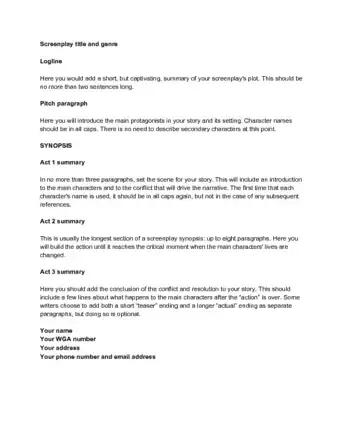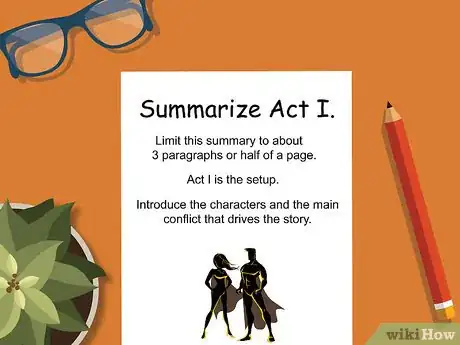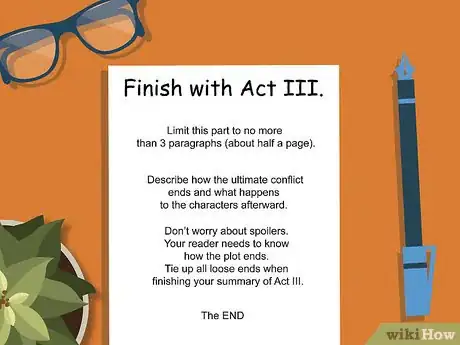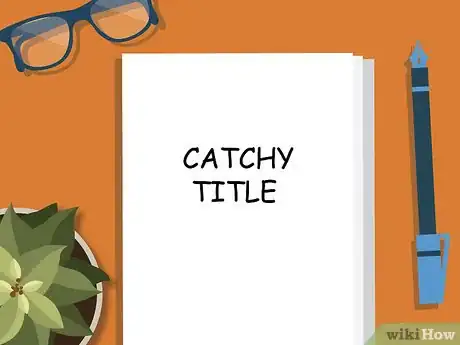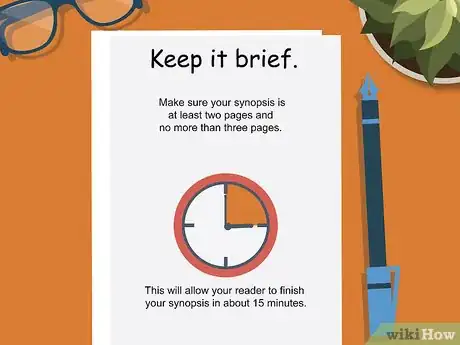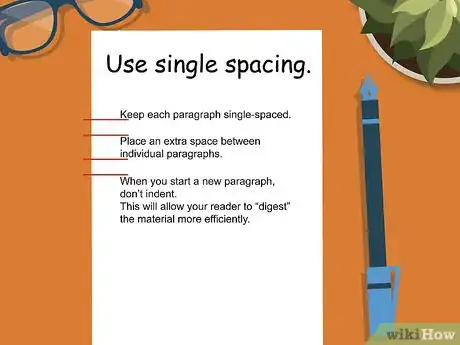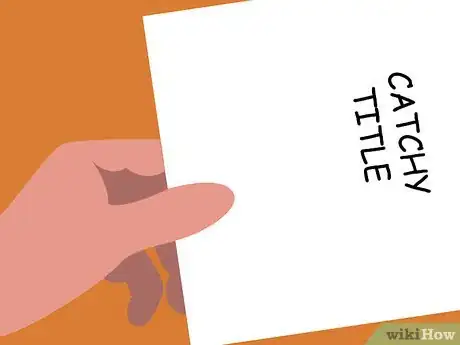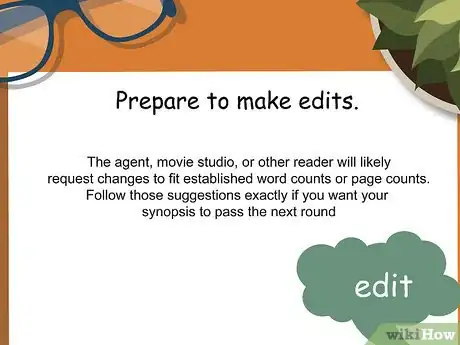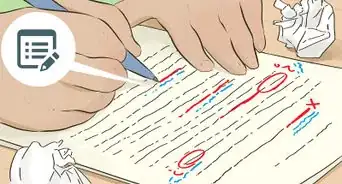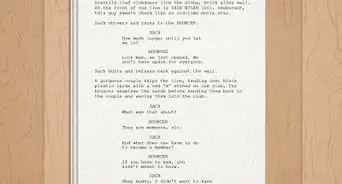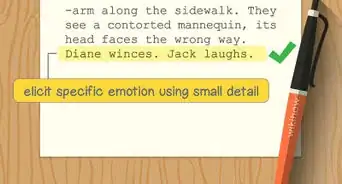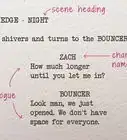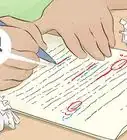This article was co-authored by Melessa Sargent. Melessa Sargent is the President of Scriptwriters Network, a non-profit organization that brings in entertainment professionals to teach the art and business of script writing for TV, features and new media. The Network serves its members by providing educational programming, developing access and opportunity through alliances with industry professionals, and furthering the cause and quality of writing in the entertainment industry. Under Melessa's leadership, SWN has won numbers awards including the Los Angeles Award from 2014 through 2021, and the Innovation & Excellence award in 2020.
There are 11 references cited in this article, which can be found at the bottom of the page.
wikiHow marks an article as reader-approved once it receives enough positive feedback. This article received 11 testimonials and 88% of readers who voted found it helpful, earning it our reader-approved status.
This article has been viewed 514,605 times.
A screenplay synopsis summarizes a screenplay for an agent, director or producer. If the reader likes the synopsis, they might ask to see the screenplay itself. Unlike a treatment, which is a narrative of everything that happens in a screenplay, a synopsis includes only the most important or interesting parts of the story. Your synopsis must summarize the plot, follow basic guidelines, and get your main point across to have a shot at success.[1]
Steps
Synopsis Template and Sample Synopsis
Summarizing the Plot
-
1Write the logline. The logline is at most two sentences that sum up your screenplay. Include the identity of the protagonist (the main character/hero), the challenge(s) they’re trying to overcome, and why they must overcome them.[2] If you can, follow the logline with a paragraph describing why your screenplay is attractive from a filmmaker's point of view.
- For example, if it can be shot on a small budget using a limited number of locations near Los Angeles, your movie might be more attractive than one that will require a distant location, elaborate sets, or a lot of special effects.
-
2Introduce the main characters and setting. Limit this part to one paragraph. Include the names (who), their occupations (what), where they live and work (where), the time period of the story (when), and the reason you’re telling their story (why).[3] Type the names of the characters in all capital letters the first time their names appear. After that, type the character names in the usual way.[4]
- Characters that should be included in the synopsis are the protagonist, the antagonist (villain), the love interest, and any important allies of the protagonist. Leave out the names of lesser characters.[5]
Advertisement -
3Summarize Act I. Limit this summary to about 3 paragraphs or half of a page. Act I is the setup. Introduce the characters and the main conflict that drives the story.[6]
-
4Cover Act II. Dedicate about a page to Act II. Show all the conflicts your characters face. Show how these conflicts lead to the crisis, or the characters’ reversal of fortune.[7]
-
5Finish with Act III. Limit this part to no more than 3 paragraphs (about half a page). Describe how the ultimate conflict ends and what happens to the characters afterward. Don’t worry about spoilers. Your reader needs to know how the plot ends. Tie up all loose ends when finishing your summary of Act III.[8]
-
6Think of a title that fits your story. You can try to make the title catchy and interesting, but the director of the movie studio will probably change it, so don't work on it too hard. Put the title at the top of the page.
Following Basic Guidelines
-
1Designate it a synopsis. This might seem obvious, but it’s easy to overlook. In the header of your document, write out the word “Synopsis” and the title of your movie. Under the title, inform your reader of the genre of you screenplay (drama, horror, comedy, etc.).[9]
- For example, a synopsis for Star Wars might include “A science fiction adventure” beneath the title.
-
2Add your contact information.[10] At the top of the first page beneath the header, enter your name, mailing address, phone number, and email address. Include your Writers Guild of America (WGA) registration number.[11]
- Always register your completed screenplay and/or treatment with the WGA to establish your authorship
-
3Keep it brief. Make sure your synopsis is at least two pages. A one-page synopsis might seem less time-consuming, but your reader will see it as lacking the necessary details. At the same time, keep it at no more than three pages.[12] This will allow your reader to finish your synopsis in about 15 minutes.
-
4Write in the present tense. Even if your plot is set in the past or the future, use present tense verbs. For example, in a screenplay for Star Wars, you might write “Obi-Wan Kenobi fights Darth Vader.” This is because the action in your screenplay happens as you write it, not in the time period you set it in.[13]
-
5Use third-person point of view. Even if you have a narrator doing voiceovers in the screenplay, the camera always takes an all-seeing viewpoint. Use pronouns like “he,” “she,” and “they.”[14] For example, you would say, “When Little Teapot gets all steamed up, he shouts to tip him over and pour him out.”
-
6Use single spacing. Keep each paragraph single-spaced. Place an extra space between individual paragraphs. When you start a new paragraph, don’t indent. This will allow your reader to “digest” the material more efficiently.
-
7Stick to a standardized typeface and font. If your reader can’t read what’s on the page, your synopsis will end up in the recycling bin. For this reason, you should avoid script- or handwriting-style typefaces. Stick to defaults like Times New Roman or Arial. Keep your font size at 12, unless the submission guidelines specify something different.[15]
Getting Your Point Across
-
1Avoid extravagant language. Write in plain, succinct language that any audience can understand.[16] In order to sell your screenplay, your reader must first understand what your plot is about. If you use jargon or flowery language, your reader probably won’t bother going past the first few paragraphs. If you pad your synopsis with unnecessary adjectives or adverbs, it’s no longer a synopsis. Stay brief, and you’ll be one step closer to your goal.[17]
-
2Give your synopsis to other people to proofread. Ask them to look for errors in spelling, grammar, and any information that isn’t clear to them. This could be a friend, family member, or colleague. If they have any questions or if something isn't clear to them, change your synopsis to make the story clearer. If your reader finds something in your synopsis that’s unclear or confusing, they won’t request your full screenplay.
-
3Prepare to make edits. Many organizations you may submit your synopsis to publish submission guidelines. Change your synopsis, if necessary, to fit those guidelines. The agent, movie studio, or other reader will likely request changes to fit established word counts or page counts. Follow those suggestions exactly if you want your synopsis to pass the next round.[18]
Expert Q&A
-
QuestionHow do you start writing a screenplay?
 Melessa SargentMelessa Sargent is the President of Scriptwriters Network, a non-profit organization that brings in entertainment professionals to teach the art and business of script writing for TV, features and new media. The Network serves its members by providing educational programming, developing access and opportunity through alliances with industry professionals, and furthering the cause and quality of writing in the entertainment industry. Under Melessa's leadership, SWN has won numbers awards including the Los Angeles Award from 2014 through 2021, and the Innovation & Excellence award in 2020.
Melessa SargentMelessa Sargent is the President of Scriptwriters Network, a non-profit organization that brings in entertainment professionals to teach the art and business of script writing for TV, features and new media. The Network serves its members by providing educational programming, developing access and opportunity through alliances with industry professionals, and furthering the cause and quality of writing in the entertainment industry. Under Melessa's leadership, SWN has won numbers awards including the Los Angeles Award from 2014 through 2021, and the Innovation & Excellence award in 2020.
Professional Writer I recommend making sure you know your idea. Write exactly what you want to your script to be about, and really understand your characters as well. To start, write everything out in paragraph form, noting things such as locations that you would like to include. Once you've written it all out, you can start to to transfer your ideas and and put them on paper using the correct formatting.
I recommend making sure you know your idea. Write exactly what you want to your script to be about, and really understand your characters as well. To start, write everything out in paragraph form, noting things such as locations that you would like to include. Once you've written it all out, you can start to to transfer your ideas and and put them on paper using the correct formatting. -
QuestionWhat software can I use to write a screenplay?
 Melessa SargentMelessa Sargent is the President of Scriptwriters Network, a non-profit organization that brings in entertainment professionals to teach the art and business of script writing for TV, features and new media. The Network serves its members by providing educational programming, developing access and opportunity through alliances with industry professionals, and furthering the cause and quality of writing in the entertainment industry. Under Melessa's leadership, SWN has won numbers awards including the Los Angeles Award from 2014 through 2021, and the Innovation & Excellence award in 2020.
Melessa SargentMelessa Sargent is the President of Scriptwriters Network, a non-profit organization that brings in entertainment professionals to teach the art and business of script writing for TV, features and new media. The Network serves its members by providing educational programming, developing access and opportunity through alliances with industry professionals, and furthering the cause and quality of writing in the entertainment industry. Under Melessa's leadership, SWN has won numbers awards including the Los Angeles Award from 2014 through 2021, and the Innovation & Excellence award in 2020.
Professional Writer I recommend using Final Draft, because they are always up to date and have great customer service. The software is also industry standard and very easy to use.
I recommend using Final Draft, because they are always up to date and have great customer service. The software is also industry standard and very easy to use. -
QuestionWhat is a spec script?
 Melessa SargentMelessa Sargent is the President of Scriptwriters Network, a non-profit organization that brings in entertainment professionals to teach the art and business of script writing for TV, features and new media. The Network serves its members by providing educational programming, developing access and opportunity through alliances with industry professionals, and furthering the cause and quality of writing in the entertainment industry. Under Melessa's leadership, SWN has won numbers awards including the Los Angeles Award from 2014 through 2021, and the Innovation & Excellence award in 2020.
Melessa SargentMelessa Sargent is the President of Scriptwriters Network, a non-profit organization that brings in entertainment professionals to teach the art and business of script writing for TV, features and new media. The Network serves its members by providing educational programming, developing access and opportunity through alliances with industry professionals, and furthering the cause and quality of writing in the entertainment industry. Under Melessa's leadership, SWN has won numbers awards including the Los Angeles Award from 2014 through 2021, and the Innovation & Excellence award in 2020.
Professional Writer Writing a spec script involves writing a new episode to a television show that is already on TV. The process requires understanding all of the characters and their individual voices so that you can carry on the show from where it left off. Many screenwriters have a couple of specs written, as they can help with your own original writing.
Writing a spec script involves writing a new episode to a television show that is already on TV. The process requires understanding all of the characters and their individual voices so that you can carry on the show from where it left off. Many screenwriters have a couple of specs written, as they can help with your own original writing.
References
- ↑ Melessa Sargent. Professional Writer. Expert Interview. 14 August 2019.
- ↑ http://www.greenlightmymovie.com/write-film-synopsis-get-results/
- ↑ http://www.greenlightmymovie.com/write-film-synopsis-get-results/
- ↑ https://screenplayreaders.com/brief-synopsis/
- ↑ http://www.writersdigest.com/editor-blogs/guide-to-literary-agents/open-ready-synopsis-example-the-ides-of-march-political-thriller
- ↑ http://www.greenlightmymovie.com/write-film-synopsis-get-results/
- ↑ http://www.greenlightmymovie.com/write-film-synopsis-get-results/
- ↑ http://www.greenlightmymovie.com/write-film-synopsis-get-results/
- ↑ https://sites.google.com/site/allaboutwritingscreenplays/the-screenwriters-synopsis
- ↑ Melessa Sargent. Professional Writer. Expert Interview. 14 August 2019.
- ↑ https://www.wgawregistry.org/
- ↑ http://www.greenlightmymovie.com/write-film-synopsis-get-results/
- ↑ http://www.scriptmag.com/features/creating-a-screenplay-narrative-in-the-absolute-present-tense
- ↑ https://sites.google.com/site/allaboutwritingscreenplays/the-screenwriters-synopsis
- ↑ https://sites.google.com/site/allaboutwritingscreenplays/the-screenwriters-synopsis
- ↑ Melessa Sargent. Professional Writer. Expert Interview. 14 August 2019.
- ↑ https://screenplayreaders.com/brief-synopsis/
- ↑ https://www.elsevier.com/reviewers/what-is-peer-review
About This Article
To write a screenplay synopsis, start by introducing the characters and setting in the first paragraph, followed by summaries of each act. Limit the synopsis to no more than 3 pages, since readers should be able to finish it within 15 minutes. To format your synopsis, create a header with the word “Synopsis,” the title of the play, and the genre. On the first page, beneath the header, include your contact information and a longline that explains your play in 2 sentences. For tips on formatting your screenplay synopsis before submitting it, keep reading.

